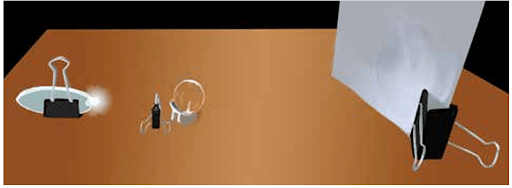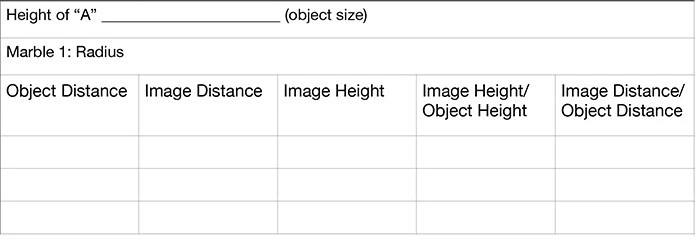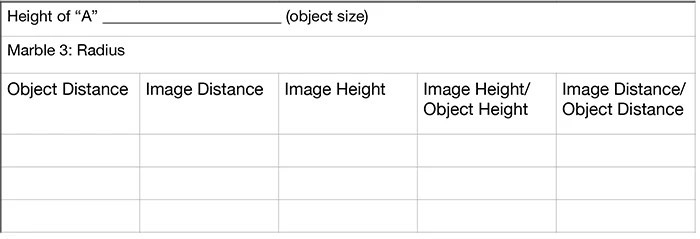Take a minute to play with a magnifying glass. Did you know they were called “spherical” lenses? This is kind of an odd name since they usually look like bulging pancakes. In this experiment you will get to learn about spheres and how they magnify and image.

Magnifying Marbles
Experimenting with an object's size and magnification
How does the radius of the sphere affect how much it magnifies an object?
This resource was originally published in PhysicsQuest 2015: Light Science.
How does the radius of the sphere affect how much it magnifies an object?
- Three sizes of water gel spheres
- Binder clips
- Transparency
- Flashlight
- Water
- Stiff paper
- Permanent marker
- White piece of paper
- Dark room
What happens when you look through a magnifying glass at a tiny bug or small writing?
What do you have to do to see the small writing or bug clearly?
Take one of the gel spheres and look at something in the room. How does it look? Is it right side up or upside down?
Pick up a gel sphere of a different size and look around the room. What’s the same? What’s different?
Cut a small piece of transparency and use the permanent marker to draw an “A” on it. Make one leg of the “A” longer than the other.
Take a tiny piece of stiff paper and roll it into a small cylinder that has a radius a bit smaller than the radius of the biggest gel sphere.
Turn on the flashlight and put it in a binder clip.
Put the white piece of paper in a binder clip to use as a screen.
Place the rolled up paper cylinder on the table and balance the largest gel sphere on top.
Place the flashlight so it shines on the sphere.
Put the transparency “A” in the small binder clip and place it between the flashlight and the gel sphere.
Put the screen on the other side of the sphere. The “A” should now be projected on the screen.

Turn off the room lights.
If you’ve set up the experiment correctly, you should see a giant “A” projected on your screen.
Move the screen back and forth until the “A” on the screen, which we’re going to call the image, is in focus. What does the image look like? Is it right side up or upside down? Is it flipped left to right or not? Draw it here:
Move the transparency “A,” which we’re going to call the object. What happened to the image? Can you get it in focus again? What did you have to do?
Measure the height of the object.
Put the object close to the sphere and focus the image on the screen.
Measure the distance from the object to the center of the sphere.
Measure the distance from the screen with the focused image to the center of the sphere.
Change the distance between the object and the sphere and take the same measurements. Do this for one more object distance.
Record your answers in the chart below.
Leave the last two columns of the chart blank for now, you’ll fill them in in the next section.
Repeat all of this for the other two marbles using the same distances from the center of the marble. You may have to make new paper stands for the different sized spheres.



In the charts you just filled in, there are two columns for your calculations of magnification, one using distances and one using heights.
What is the magnification for each object distance? Is the magnification the same for any object distance?
How does the radius of the sphere change how much it magnifies an object? Is it the same for any object distance?
To get a better idea of how magnification changes as the radius of the sphere changes, make a graph with radius on the x axis and magnification on the y axis. You will have to decide on your own what scale you should put on your x and y axes. Do this for all three object distances on the same graph.
Do the graphs look similar for each object distance or do they look different?
How do you think a marble the size of a pea would magnify an object? What about a bowling ball?